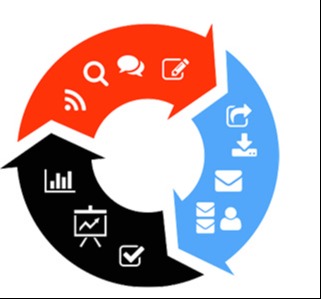It's not too late, but it is time for action
Rest assured, it's not too late to modernize your services (even if you make products) to current times. You're not alone in recognizing this urgency. According to Salesforce research(State of Marketing 2020), 69% of B2B marketers feel that traditional marketing limits customer engagement. So we know it, but are we acting on it?
Either way, now is the time to choose! And if you choose to modernize your customer service, choose well! Don't just add it on, go all-in.
Out with the "cut and paste" department, claim your place at the drawing board.
With all due respect to marketing professionals working in the marketing and/or communications domain, we still too often allow ourselves to be seduced into thinking and acting from means. I still see in a majority of B2B companies a marketing and communications department that is only engaged in the better cut and paste work. Right; creating communication tools. And often commissioned by 'the business'.
Marketing must claim its place at the drawing board! If there is one business unit that can identify customer needs and translate them into good propositions, it is marketing. In my opinion, marketing should have a more strategic role. Only then can you really respond to the changes in the market and implement a much-needed transition in your organization in which your customer is the starting point. Then you do not "forget" to change to a more online-oriented organization.
Start REALLY with your customers
You hear thebuzzwords around you left and right: customer centricity, customer focus, our customer is king and I could list a few more. It often remains a nice promise. It is therefore not easy to listen well to your (potential) customers.
Indeed ... it takes quite some time and attention. That is why many companies start with themselves and the products or services they sell. Often without asking themselves whether anyone is actually waiting for them. That has to change! The successful companies are those that DO add real value to their customers. In fact, by helping their customers in the best way possible. In that context, there is really only one credo you MUST remember: "Stop selling and start helping.
Make an impact with your inbound strategy
And that credo brings you right to the heart of inbound marketing. Stop selling your products and start helping your (potential) customers fulfill their needs and challenges. If you get that, the deal will come naturally. Inbound marketing is about guiding your customers through their buying journey(buyer journey). The one who understands the customer best and helps them best during their buying process has the greatest chance of ultimately winning the customer. And the great thing is ... today's technologies allow us to be relevant at the right time with the right information.
Now you may be asking yourself how to go about it, such an inbound marketing strategy. Below I show you what 3 steps in my opinion are absolutely necessary to shape this successfully.
- Start from your business ambitions and goals and choose your focus market
A good marketing strategy starts with the goals of the organization. The goals determine the best strategy to follow to achieve them. So not the means! Sounds logical, yet many organizations start with the means and not the ends. And then it's choice blown. So choose the market, or better the product-market combination, that gives you the best chance to achieve your goals. Choosing is key here. If you don't choose you're never going to be truly relevant. If you choose for everyone, you're actually choosing for no one. - Identify the key buyer persona*
Once you've chosen your key product-market combination, make the move to the organizational level. What does your ideal customer look like? Big, small, certain turnover? Once you know that, you can also identify what the decision making unit (DMU) of such a typical customer looks like. Who is going to actively seek a solution to their challenges related to your products or services? And who ultimately makes the decision? Here, pick the one who has the most impact on the buying process. That's going to be your most important buyer persona. That's the one you're going to focus on. Again, choose. Start with the most important one (often not the final decision maker) and only later expand to the next one. Focus is key here, too. - Really get to know your buyer persona and understand his challenges
Now that you know who is most important, you can start getting inside his/her head. Don't do that superficially. Your goal should be to really understand him/her completely. By understanding what his goals and challenges are and by understanding what "pains" he experiences in them. You also want to know what makes him happy; his gains. You don't need years of research for this. Most of the knowledge already exists in your organization. Start with your sales and customer service people. They have contact with your customers every day. They are going to give you 80% of the information. The other 20% you will validate in practice. Because"the proof of the pudding is in the eating.
Are you there now? No, of course not. This is only the beginning. But an absolutely necessary beginning. So get started with this first. Make sure you choose sharply and have a good idea of your buyer persona. In the next blog I will show you what the next steps are and how to implement an effectiveinbound marketing strategy.
*Frame: explanation buyer persona
A buyer persona is a semi-fictional representation of your buyers, telling you what their goals, challenges, pains and gains are. A good buyer persona helps you and the people in your organization to help him/her in his/her buyer journey. Check out our white paper on buyer personas for more info on how to put together a good buyer persona.




